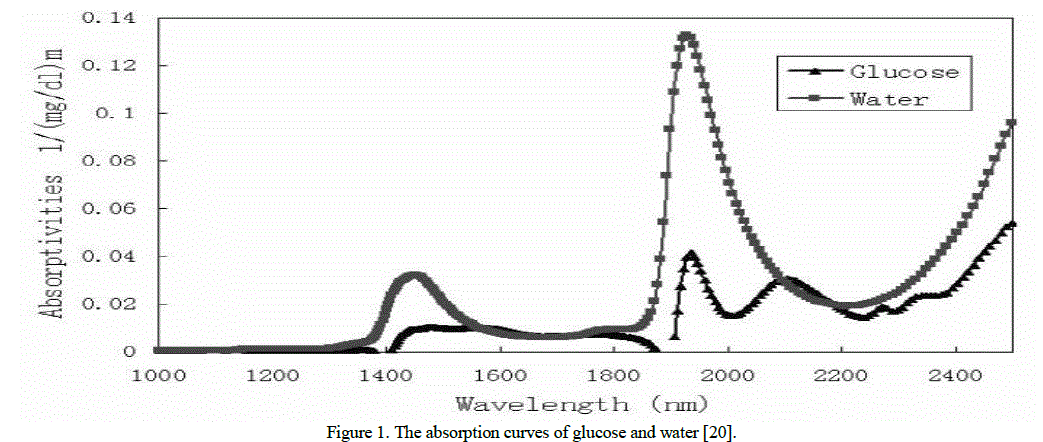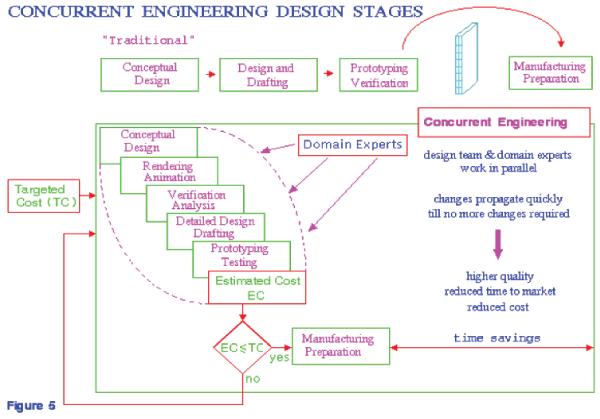The project‟s aims were to identify the critical constraints with respect to global manufacturing, and to synthesise the best practices of concurrent engineering (CE) in a number of industrial sectors including automotive, aerospace, telecommunication, shipbuilding, and information technology. The consortium was constructed from a cohesive group of world class companies and research institutions from the USA, Canada, and Europe. The research outcome indicated that effective communication, a systematic involvement of customers, suppliers; distributors, powerful information infrastructure, and effective use of modern technology are vital key elements for success
Keywords |
| Globalisation; Concurrent engineering; Product life cycle; Organisational strategy; Communication
infrastructure; |
INTRODUCTION |
| Publication in 2008 described the concurrent engineering method as a relatively new design management system that
has had the opportunity to mature in recent years to become a well-defined systems approach towards optimizing
engineering design cycles.[1] Because of this, concurrent engineering has been implemented in a number of companies,
organizations and universities, most notably in the aerospace industry. Beginning in the early 1990s, CE was also
adapted for use in the information and content automation field, providing a basis for organization and management of
projects outside the physical product development sector for which it was originally designed. |
| The basic premise for concurrent engineering revolves around two concepts. The first is the idea that all elements of a
product‟s life-cycle, from functionality, producibility, assembly, testability, maintenance issues, environmental impact
and finally disposal and recycling, should be taken into careful consideration in the early design phases.[2] |
| The second concept is that the preceding design activities should all be occurring at the same time, i.e., concurrently.
The idea is that the concurrent nature of these processes significantly increases productivity and product
quality.[3] This way, errors and redesigns can be discovered early in the design process when the project is still flexible.
By locating and fixing these issues early, the design team can avoid what often become costly errors as the project
moves to more complicated computational models and eventually into the actual manufacturing of hardware.[4] |
| As mentioned above, part of the design process is to ensure that the entire product's life cycle is taken into
consideration. This includes establishing user requirements, propagating early conceptual designs, running
computational models, creating physical prototypes and eventually manufacturing the product. Included in the process
is taking into full account funding, work force capability and time. A study in 2006 claimed that a correct
implementation of the concurrent design process can save a significant amount of money, and that organizations have
been moving to concurrent design for this reason.[3] |
| Concurrent engineering replaces the more traditional sequential design flow, or „Waterfall Model‟.[5][6] In concurrent
engineering an iterative or integrated development method is used instead.[7] The difference between these two
methods is that the „Waterfall‟ method moves in a linear fashion by starting with user requirements and sequentially
moving forward to design, implementation and additional steps until you have a finished product. In this design system,
a design team would not look backwards or forwards from the step it is on to fix possible problems. In the case that |
| something does go wrong, the design usually must be scrapped or heavily altered. On the other hand, the iterative
design process is more cyclic in that, all aspects of the life cycle of the product are taken into account, allowing for a
more evolutionary approach to design.[8] The difference between the two design processes can be seen graphically in
Figure 1. |
 |
| A significant part of the concurrent design method is that the individual scientist is given much more say in the overall
design process due to the collaborative nature of concurrent engineering. Giving the designer ownership is claimed to
improve the productivity of the employee and quality of the product that is being produced, based on the assumption
that people who are given a sense of gratification and ownership over their work tend to work harder and design a more
robust product, as opposed to an employee that is assigned a task with little say in the general process.[4] |
DESIGN PROCESSES |
| The design process for concurrent engineering can vary quite a bit depending on the size and nature of the project.
However, most approaches follow a similar structure outlined below: |
| • Define customer requirements |
| • Define engineering requirements |
| • Conceive design solutions |
| • Customer Requirements |
| • Come up with multiple designs/ideas |
| • Approval |
| • Funding |
| • Happens throughout process |
| • Develop prototypes |
| • Develop/optimize few ideas from original concepts |
| • Approval |
| • Implement design |
| • recheck |
DFM GUIDELINES |
| • Design for a minimum number of parts |
| • Develop a modular design |
| • Minimize part variations |
| • Design parts to be multifunctional |
| • Design parts for multiuse |
| • Design parts for ease of fabrication |
| • Avoid separate fasteners |
| • Minimize assembly directions; design for top-down assembly |
| • Maximize compliance; design for ease of assembly |
| • Minimize handling; design for handling presentation |
| • Evaluate assembly methods12. Eliminate adjustments |
| • Avoid flexible components; they are difficult to handle |
| • Use parts of known capability |
| • Allow for maximum intolerance of parts |
| • Use known and proven vendors and suppliers |
| • Use parts at de-rated values with no marginal overstress |
| • Minimize subassemblies |
| • Use new technology only when necessary |
| • Emphasize standardization |
| • Use the simplest possible operations |
| • Use operations of known capability |
| • Minimize setups and interventions |
| • Undertake engineering changes in batches |
CONCURRENT ENGINEERING ELEMENTS |
4.1 Cross-functional teams: |
| Include members from various disciplines involved in the process, including manufacturing, hardware and software
design, marketing, and so forth. |
4.2 Concurrent product realization: |
| Process activities are at the heart of concurrent engineering. Doing several things at once, such as designing various
subsystems simultaneously, is critical to reducing design time. |
4.3 Incremental information sharing: |
| It helps minimize the chance that concurrent product realization will lead to surprises. As soon as new information
becomes available, it is shared and integrated into the design. Cross functional teams are important to the effective
sharing of information in a timely fashion. |
4.4 Integrated project management: |
| It ensures that someone is responsible for the entire project, and that responsibility is not abdicated once one aspect of
the work is done. |
 |
CONCLUSION |
| Designing for manufacturability is a principle that engineers use to design parts that can be easily manufactured. DFM
is usually a principle that concentrates on reducing the cost of part production. Designing for manufacturability should
start at the beginning of product development and should be improved upon throughout the design process. Engineering
should work with manufacturing and other functional groups to design parts that can be easily manufactured. By
thinking about the manufacturability of parts from the beginning of a project, engineers and manufacturing can work
together to create cost effective parts that satisfy both groups. Parts that are designed for manufacturability and
assembly generally cost less to produce than parts that are not designed with these considerations. Since cost reduction
is one of the main goals of DFM, DFM is a principle known and used at most companies. |
References |
- Ma, Y., Chen, G. & Thimm, G.; "Paradigm Shift: Unified and Associative Feature-based Concurrent Engineering and Collaborative Engineering", Journal of Intelligent Manufacturing, DOI 10.1007/s10845-008-0128-y
- Kusiak, Andrew; Concurrent Engineering: Automation, Tools and Techniques
- Quan, W. & Jianmin, H., A Study on Collaborative Mechanism for Product Design in Distributed Concurrent Engineering IEEE 2006. DOI:10.1109/CAIDCD.2006.329445
- Kusiak, Andrew, Concurrent Engineering: Automation, Tools and TechniquesâÃâ¬ÃÅThe standard waterfall model for systems developmentâÃâ¬ÃÂ, NASA Webpage, November 14, 2008
- Kock, N. and Nosek, J., âÃâ¬ÃÅExpanding the Boundaries of E-CollaborationâÃâ¬ÃÂ, IEEE Transactions on Professional Communication, Vol 48 No 1,March 2005.
- Ma, Y., Chen, G., Thimm, G., "Paradigm Shift: Unified and Associative Feature-based Concurrent Engineering and Collaborative
- Engineering", Journal of Intelligent Manufacturing, DOI 10.1007/s10845-008-0128-y
- Royce, Winston, "Managing the Development of Large Software Systems", Proceedings of IEEE WESCON 26 (August 1970): 1-9.
- Kusiak, Andrew, "Concurrent Engineering: Automation, Tools and Techniques"
- Rosenblatt, A. and Watson, G. (1991). "Concurrent Engineering", IEEE Spectrum, July, pp 22-37.
- Winner, Robert I., Pennell, James P., Bertrand, Harold E., and Slusarczuk, Marko M. G. (1991). "The Role of Concurrent Engineering in Weapons System Acquisition", Institute for Defense Analyses Report R-338, December 1988, p v
|